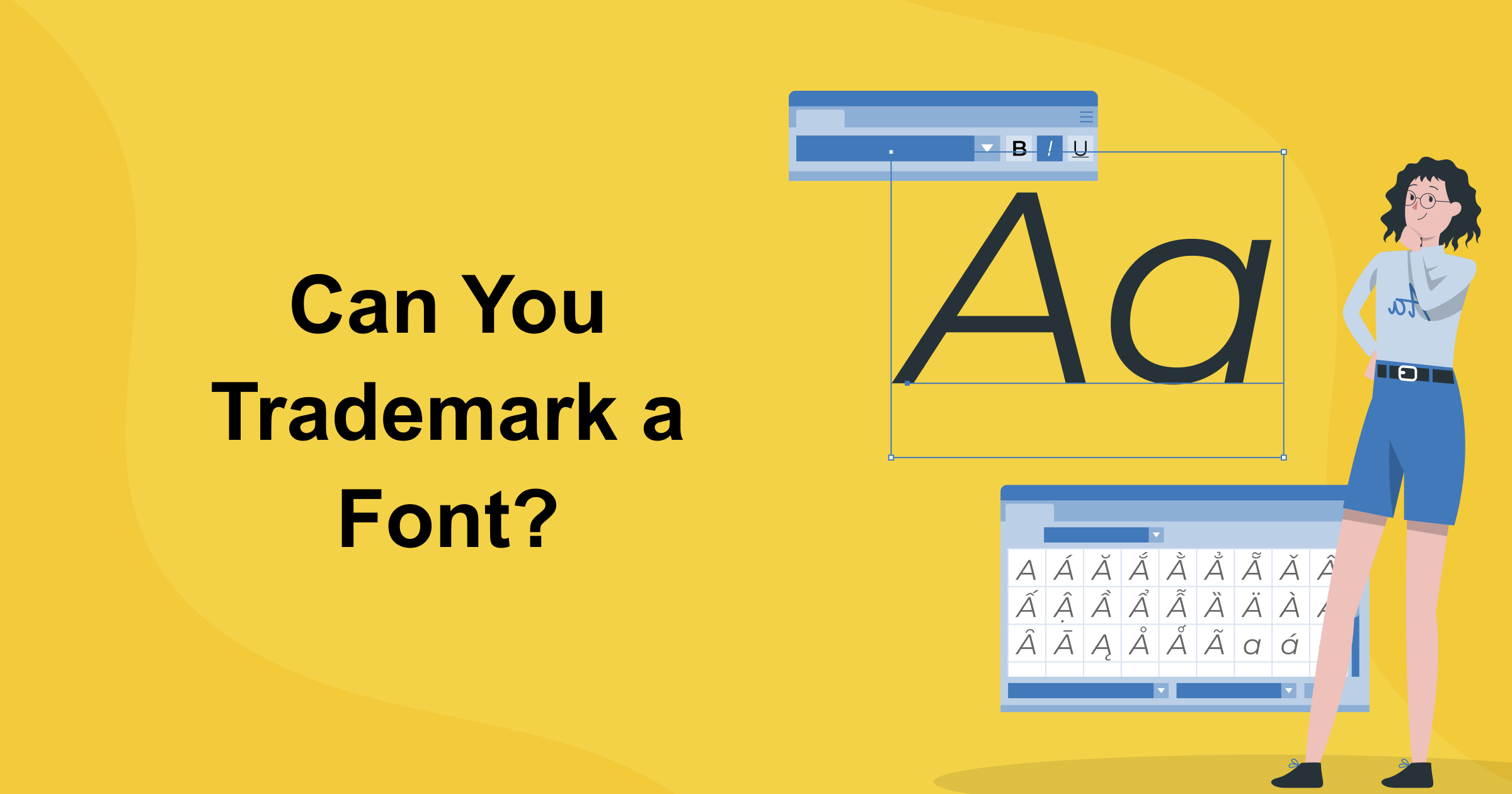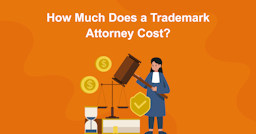Trady
26 April 2024 • 4 min read

ter shouIn today's visually driven market, the distinctiveness of branding can be as crucial as the quality of products or services.
A unique font can play a pivotal role in setting a brand apart.
But when it comes to legal protections, can you trademark a font?
This article delves into the essence of trademarks, defines what constitutes a font, explores additional intellectual property considerations for fonts, and discusses how trademark rights function.
Plus, we'll provide insights on safeguarding your brand using Trademarkia.
Whether you're a graphic designer, a business owner, or simply curious about intellectual property, this guide will equip you with the knowledge to understand and potentially protect your typographic assets.
According to trademark law:
A trademark is a type of intellectual property protection that identifies and distinguishes the source of goods or services.
It can be a word, phrase, symbol, design, or a combination of these, that signifies a company's brand identity in the marketplace.
Trademarks are used to protect a brand's reputation.
By securing a trademark, a business can ensure that its branding elements aren't used without permission, thus avoiding confusion among consumers and protecting the business's integrity.
Protect your business from trademark infringement today at Trademarkia. Get in touch with one of our registered intellectual property attorneys today!
A font is more than just a set of characters:
It's a comprehensive design of alphanumeric symbols and punctuation marks with consistent stylistic themes.
This includes the specific size, weight, and style of each character.
Fonts are crafted to convey readability and aesthetic appeal, often evoking particular emotions or associations.
Each font variant, whether bold, italic, or underlined, forms part of a broader typeface family that maintains coherent design traits across different textual environments.
Understanding what makes each font unique is essential to appreciating their role in branding and design and in discussions about intellectual property rights.
The ability to trademark a font depends significantly on its distinctiveness and association with a particular source of goods or services.
Generally, the font's design — meaning the specific way characters are styled and presented— cannot be trademarked unless it functions as a logo or part of branding material that uniquely identifies a business.
For example, the stylized use of a font in a company logo can be trademarked because it serves to distinguish the brand in commerce.
However, as a type design, the font alone usually doesn't meet the criteria for trademark protection since it doesn't inherently indicate a single source or origin of products or services.
Learn more about trademark applications in our guide: What to Expect When Applying for a Trademark: A Comprehensive Guide.
While a trademark might not cover the font itself, other intellectual property forms can provide essential protections.
Copyright law guards the computer program that displays how the character should be shown, but not the typeface itself.
However:
A design patent could be a strategic choice for distinctive designs, protecting a font's unique, non-functional aesthetic features.
This type of patent prevents others from using the design or substantially similar ones without permission.
In the US, design patents last 15 years from the date of grant, allowing designers to exclusively capitalize on their creative work during this period.
Therefore, combining different types of intellectual property protections can be crucial for securing comprehensive rights to a font.

Trademark rights are established to protect brand identity by distinguishing the goods or services of one business from those of others.
These rights are obtained through registration with a government body, such as the US Patent and Trademark Office (USPTO), or through the actual use of the mark in commerce, which can establish common law rights in the geographic area where the mark is used.
Registered trademarks provide more robust protections, including exclusive rights to use the mark nationwide and the ability to bring legal action against infringement in federal court.
Additionally, owning a registered trademark can deter others from using a similar mark through the public notice of the trademark registry.
Trademark rights can be maintained indefinitely, provided the mark is continually used in commerce and periodic renewal filings are made to keep the registration active.
Securing the intellectual property rights of your font is crucial for maintaining its uniqueness and preventing unauthorized use.
Trademarkia offers a comprehensive platform to help you navigate the complexities of trademarks, copyright, and design patents.
By using Trademarkia, you can:
This proactive approach safeguards your creative work and strengthens your brand's identity and competitive edge.
Whether you're looking to protect a distinctive typeface or a stylized font used in branding, Trademarkia provides the tools and expertise to secure your intellectual property rights efficiently and effectively.
You usually need permission to use font designs, particularly for commercial purposes, because fonts are often licensed with specific terms dictating their use. For commonly used, pre-installed fonts like Arial, the license included with your operating system or software generally allows broad usage, including for business and marketing.
However, for fonts acquired outside of these pre-installed options, it's important to review the license to ensure compliance with any limitations or requirements specified.
Yes, fonts can be patented, particularly if they incorporate a novel typeface design or a unique font technology. However, patents on fonts are less common than copyright protection since they require demonstrating the novelty and nonobviousness of the design or technology.
Yes, many fonts are copyrighted. Copyright protects the artistic and visual representation of the typeface but not the functional aspect (the characters themselves). This protection applies to the font's design and typically lasts for the lifetime of the creator plus 70 years in many jurisdictions.
The trademark symbol (™) can be depicted in any font and style as it isn't restricted to a specific design. Its primary function is to denote that a term or logo is being claimed as a trademark, regardless of the typeface used.
Fonts can be both copyrighted and (in a way) trademarked. These protections serve different purposes. Copyright protects the specific design of a font, while a trademark might protect the name of the font or specific usage of a font in a logo or brand identifier. Each type of protection covers different aspects of how a font can be used and replicated.
AUTHOR
Introducing Trady, the charming AI personality and resident "Creative Owl" authoring the Trademarkia blog with a flair for the intellectual and the whimsical. Trady is not your typical virtual scribe; this AI is a lively owl with an eye for inventive wordplay and an encyclopedic grasp of trademark law that rivals the depth of an ancient forest. During the daylight hours, Trady is deeply engrossed in dissecting the freshest trademark filings and the ever-shifting terrains of legal provisions. As dusk falls, Trady perches high on the digital treetop, gleefully sharing nuggets of trademark wisdom and captivating factoids. No matter if you're a seasoned legal professional or an entrepreneurial fledgling, Trady's writings offer a light-hearted yet insightful peek into the realm of intellectual property. Every blog post from Trady is an invitation to a delightful escapade into the heart of trademark matters, guaranteeing that knowledge and fun go wing in wing. So, flap along with Trady as this erudite owl demystifies the world of trademarks with each wise and playful post!
Related Blogs

How Much Does a Trademark Attorney Cost?...
07 May 2024 • 6 min read

Is Filing a Trademark Hard? (+ How to Ma...
03 May 2024 • 7 min read

What Is the Most Common Reason That a Tr...
03 May 2024 • 6 min read

Can You Trademark a Name Without a Busin...
03 May 2024 • 7 min read

Is a Trademark Worth It for a Small Busi...
30 April 2024 • 7 min read